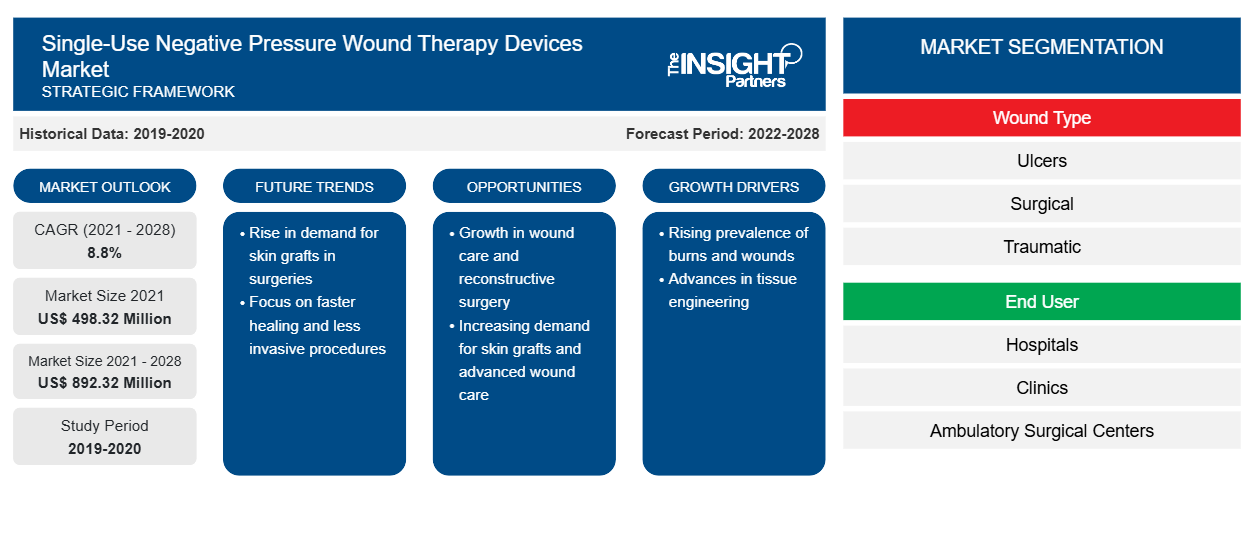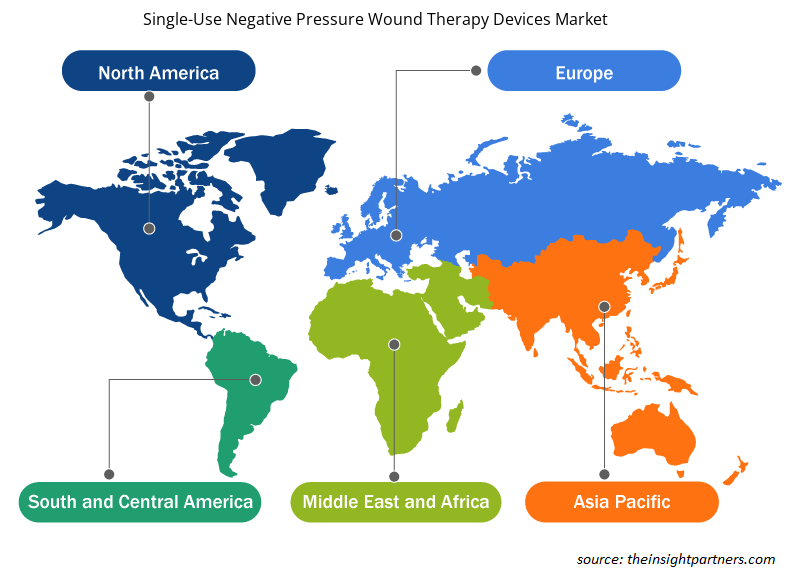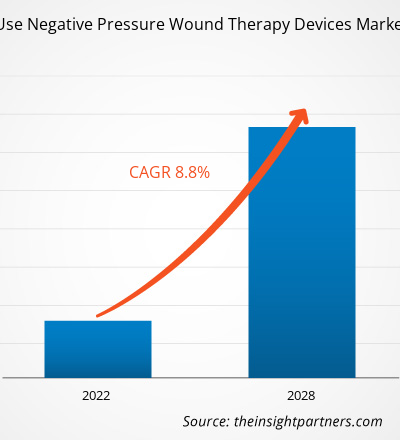Si prevede che il mercato dei dispositivi monouso per la terapia delle ferite a pressione negativa raggiungerà gli 892,32 milioni di dollari entro il 2028, rispetto ai 498,32 milioni di dollari del 2021; si prevede che registrerà un CAGR dell'8,8% dal 2021 al 2028.CAGR of 8.8% from 2021 to 2028.
La terapia delle ferite a pressione negativa (NPWT) è utilizzata per gestire un'ampia gamma di tipi di ferite, tra cui ferite traumatiche, difficili da guarire e croniche. È anche utilizzata per gestire ferite coperte da lembi o un innesto cutaneo. Questa terapia è trasformata in un dispositivo medico come un dispositivo NPWT monouso, che è un piccolo dispositivo tascabile alimentato a batteria. Come suggerisce il nome, si tratta di dispositivi monouso e portatili generalmente utilizzati per l'assistenza ambulatoriale.NPWT) is used for managing a wide range of wound types, including traumatic, hard-to-heal, and chronic wounds. It is also used to manage wounds covered with flaps or a skin graft. This therapy is transformed into a medical device such as a single-use NPWT device, which is a small pocket-sized battery-operated device. As the name suggests, these are disposable and portable devices generally used for out-patient care.
Il rapporto offre approfondimenti e analisi approfondite del mercato dei dispositivi monouso per la terapia delle ferite a pressione negativa, sottolineando vari parametri quali tendenze di mercato, progressi tecnologici, dinamiche di mercato e analisi del panorama competitivo dei principali attori del mercato in tutto il mondo. Include anche l'impatto della pandemia di COVID-19 sul mercato in tutte le regioni. Il mercato dei dispositivi monouso per la terapia delle ferite a pressione negativa ha registrato un deficit all'inizio della crisi del COVID-19 a causa dell'interruzione della catena di fornitura e del crollo della domanda dovuto al blocco annunciato dalla maggior parte dei paesi in tutto il mondo che ha causato interruzioni nella produzione e nelle operazioni nel settore farmaceutico. Inoltre, i servizi per la cura delle ferite croniche si sono ridotti drasticamente nel primo e nel secondo trimestre del 2020, ma si sono normalizzati alla fine del 2020. Inoltre, per ridurre la contaminazione incrociata attraverso i dispositivi, le persone preferiscono i dispositivi monouso. Il crescente utilizzo di dispositivi NPWT monouso (monouso) sta alimentando la loro domanda nel mercato globale dei dispositivi monouso per la terapia delle ferite a pressione negativa. Inoltre, c'è stato un calo significativo di pazienti ricoverati e ambulatoriali per le catene di ospedali privati. Per alleviare i sistemi sanitari, molte cliniche hanno posticipato diagnosi e trattamento a parte il COVID-19. Ad esempio, in India, l'ospedale statale Victoria affiliato al Bangalore Medical College and Research Institute (BMCRI) è stato convertito in una struttura dedicata al COVID-19 da quando la pandemia ha colpito il Karnataka a marzo, il funzionamento del reparto ustionati Mahabodhi nell'ospedale non è stato colpito. Nonostante la pandemia, l'ospedale ha continuato a funzionare normalmente, seguendo tutte le precauzioni per il COVID-19.NPWT devices is fueling their demand in the global single-use negative pressure wound therapy devices market market. Also, there has been a significant drop in in-patients and out-patients for private hospital chains. To relieve healthcare systems, many clinics have been postponing diagnosis and treatment apart from COVID-19. For instance, in India, the State-run Victoria hospital affiliated with the Bangalore Medical College and Research Institute (BMCRI) was converted into a dedicated COVID-19 facility ever since the pandemic hit Karnataka in March, the functioning of the Mahabodhi Burns Ward in the hospital has not been hit. Despite the pandemic, the hospital continued to operate normally, following all COVID-19 precautions.
Personalizza questo report in base alle tue esigenze
Riceverai la personalizzazione gratuita di qualsiasi report, comprese parti di questo report, o analisi a livello nazionale, pacchetto dati Excel, oltre a usufruire di grandi offerte e sconti per start-up e università
Dispositivi monouso per la terapia delle ferite a pressione negativa Mercato: approfondimenti strategici

- Scopri le principali tendenze di mercato in questo rapporto.Questo campione GRATUITO includerà analisi di dati che spaziano dalle tendenze di mercato alle stime e alle previsioni.
La gestione delle ferite croniche durante la pandemia è stata un compito molto difficile per entrambe le parti, pazienti e medici. Per ridurre al minimo il rischio di esposizione durante la pandemia, i pazienti hanno utilizzato dispositivi monouso anziché dispositivi NPWT convenzionali. A causa di problemi di salute, le persone hanno preferito utilizzare prodotti monouso per gestire le ferite croniche e acute. Questo fattore ha sostenuto la crescita del mercato durante la situazione pandemica. Il mercato dei dispositivi monouso per la terapia delle ferite a pressione negativa è segmentato in base al tipo di ferita, all'utente finale e all'area geografica. Il mercato, in base alla regione, è segmentato in Nord America, Europa, Asia Pacifico, Medio Oriente e Africa e Sud e Centro America.
Market Insights
Aumento dei casi di ustioni
Nel 2019, sono stati identificati in tutto il mondo 8.378.122 nuovi casi di ustioni. I tassi di mortalità per ustioni sono diminuiti in molte nazioni ad alto reddito, ma i decessi infantili per ustioni sono ora circa 7 volte maggiori nei paesi a basso e medio reddito rispetto ai paesi ad alto reddito. Il sistema monouso per la terapia delle ferite a pressione negativa viene utilizzato per trattare ferite acute e croniche e incisioni chirurgiche chiuse con livelli di essudato da bassi a moderati. La terapia delle ferite a pressione negativa (NPWT) prevede l'applicazione di una pressione negativa (un vuoto) a una ferita per gestirla e promuovere la guarigione. La terapia a pressione negativa topica (TNP), la chiusura assistita dal vuoto (VAC) e l'aspirazione superficiale sigillata delle ferite sono tra gli altri nomi per la NPWT. La NPWT viene utilizzata per aiutare a drenare il fluido in eccesso e migliorare il flusso sanguigno localizzato nei pazienti ustionati. È stato suggerito che l'azione della NPWT può determinare un aumento dell'ossigeno e del nutrimento forniti alla ferita, promuovendo la guarigione. Il sistema monouso per la terapia delle ferite a pressione negativa è destinato a individui che trarrebbero beneficio da un dispositivo di aspirazione (terapia delle ferite a pressione negativa), in quanto aiuta a promuovere la guarigione delle ferite rimuovendo quantità basse o moderate di essudato e detriti infettivi. Ferite croniche, acute, traumatiche, subacute e deiscenti; ustioni a spessore parziale; ulcere (come diabetiche o da pressione); lembi e innesti; incisioni chirurgiche chiuse sono tutti esempi di tipi di ferite accettabili.
Inoltre, secondo il Children's Burn Trust e la British Burn Association, 625 bambini vengono ricoverati ogni mese presso un NHS Burns Service a causa di ustioni o scottature. Nel 2017, i servizi per ustioni e scottature del NHS hanno curato oltre 15.000 pazienti con queste lesioni, con un costo totale di oltre 24,94 milioni di dollari USA (ovvero 20 milioni di sterline). Oltre 40 dei ricoveri totali per ustioni nel 2017 sono stati classificati come estremamente gravi, con procedure di trattamento che sono costate oltre 118.455,50 dollari USA (95.000 sterline) a persona. Le ustioni causate da incidenti domestici e industriali sono in aumento nelle regioni in via di sviluppo come Asia Pacifico, Africa e Medio Oriente. Pertanto, il mercato dei dispositivi monouso per la cura delle ferite a pressione negativa è guidato da un aumento del numero di casi di ustioni e lesioni simili.NHS Burns Service each month owing to burn or scald injuries. In 2017, the NHS's burns and scalds services treated more than 15,000 patients with these injuries, with a total cost of more than US$ 24.94 million (i.e., GBP 20 million). More than 40 of the total burn treatment admissions in 2017 were classified as extremely serious, with treatment procedures costing more than US$ 118,455.50 (GBP 95,000) per person. Burns caused by home and industrial mishaps are rising in developing regions such as Asia Pacific, Africa, and the Middle East. Therefore, the market for single-use negative pressure wound care devices is being driven by an increase in the number of occurrences of burns and similar injuries.
Approfondimenti basati sul tipo di ferita
Il mercato globale dei dispositivi monouso per la terapia delle ferite a pressione negativa, in base al tipo di ferita, è stato suddiviso in ulcere, ferite chirurgiche, ferite traumatiche, lesioni sportive, lembi e innesti e ustioni. Nel 2022, il segmento traumatico ha rappresentato la quota maggiore del mercato; si prevede inoltre che continuerà a dominare nel periodo di previsione. Questo tipo di ferita è il più comune a causa della crescente prevalenza di incidenti stradali e casi di trauma. Inoltre, si prevede che il segmento traumatico registrerà il CAGR più elevato nel periodo 2021-2028.CAGR during 2021–2028.
Informazioni basate sull'utente finale
In base all'utente finale, il mercato dei dispositivi monouso per la terapia delle ferite a pressione negativa è stato segmentato in ospedali, cliniche, centri chirurgici ambulatoriali e altri. Il segmento ospedaliero ha detenuto la quota maggiore del mercato nel 2022 e si stima che registrerà il CAGR più elevato durante il periodo di previsione.CAGR during the forecast period.
Gli operatori del mercato dei dispositivi monouso per la terapia delle ferite a pressione negativa adottano strategie organiche, come il lancio e l'espansione dei prodotti, per espandere la propria presenza e il portafoglio prodotti in tutto il mondo e soddisfare la crescente domanda.
Approfondimenti basati sulla geografia
In base alla geografia, il mercato dei dispositivi monouso per la terapia delle ferite a pressione negativa è segmentato in Nord America (Stati Uniti, Canada e Messico), Europa (Francia, Germania, Regno Unito, Spagna, Italia e resto d'Europa), Asia Pacifico (Cina, India, Giappone, Australia, Corea del Sud e resto dell'APAC), Medio Oriente e Africa (Arabia Saudita, Emirati Arabi Uniti, Sudafrica e resto dell'area MEA) e America meridionale e centrale (Brasile, Argentina e resto dell'America meridionale e centrale).APAC), the Middle East & Africa (Saudi Arabia, the UAE, South Africa, and the Rest of MEA), and South & Central America (Brazil, Argentina, and the Rest of South & Central America).
Approfondimenti regionali sul mercato dei dispositivi monouso per la terapia delle ferite a pressione negativa
Le tendenze regionali e i fattori che influenzano il mercato dei dispositivi monouso per la terapia delle ferite a pressione negativa durante il periodo di previsione sono stati ampiamente spiegati dagli analisti di Insight Partners. Questa sezione discute anche i segmenti di mercato dei dispositivi monouso per la terapia delle ferite a pressione negativa e la geografia in Nord America, Europa, Asia Pacifico, Medio Oriente e Africa e America meridionale e centrale.

- Ottieni i dati specifici regionali per il mercato dei dispositivi monouso per la terapia delle ferite a pressione negativa
Ambito del rapporto di mercato sui dispositivi monouso per la terapia delle ferite a pressione negativa
| Attributo del report | Dettagli |
|---|---|
| Dimensioni del mercato nel 2021 | 498,32 milioni di dollari USA |
| Dimensioni del mercato entro il 2028 | 892,32 milioni di dollari USA |
| CAGR globale (2021 - 2028) | 8,8% |
| Dati storici | 2019-2020 |
| Periodo di previsione | 2022-2028 |
| Segmenti coperti | Per tipo di ferita
|
| Regioni e Paesi coperti | America del Nord
|
| Leader di mercato e profili aziendali chiave |
|
Dispositivi monouso per la terapia delle ferite a pressione negativa Densità degli attori del mercato: comprendere il suo impatto sulle dinamiche aziendali
Il mercato dei dispositivi monouso per la terapia delle ferite a pressione negativa sta crescendo rapidamente, spinto dalla crescente domanda degli utenti finali dovuta a fattori quali l'evoluzione delle preferenze dei consumatori, i progressi tecnologici e una maggiore consapevolezza dei benefici del prodotto. Con l'aumento della domanda, le aziende stanno ampliando le loro offerte, innovando per soddisfare le esigenze dei consumatori e capitalizzando sulle tendenze emergenti, il che alimenta ulteriormente la crescita del mercato.
La densità degli operatori di mercato si riferisce alla distribuzione di aziende o società che operano in un particolare mercato o settore. Indica quanti concorrenti (operatori di mercato) sono presenti in un dato spazio di mercato in relazione alle sue dimensioni o al valore di mercato totale.
Le principali aziende che operano nel mercato dei dispositivi monouso per la terapia delle ferite a pressione negativa sono:
- Cardinale Salute Inc
- Gruppo ConvaTec Plc
- Carilex Medico
- Genadyne Biotechnologies, Inc.
- Assistenza sanitaria H e R
Disclaimer : le aziende elencate sopra non sono classificate secondo un ordine particolare.

- Ottieni la panoramica dei principali attori del mercato dei dispositivi monouso per la terapia delle ferite a pressione negativa
Approfondimenti basati sull'azienda
Cardinal Health Inc; ConvaTec Group Plc; Carilex Medical; Genadyne Biotechnologies, Inc.; H and R Healthcare; Lohmann & Rauscher GmbH & Co. KG; Medela AG; Mölnlycke Health Care AB; Paul Hartmann Ag; e Smith & Nephew plc sono tra le aziende leader che operano nel mercato dei dispositivi monouso per la terapia delle ferite a pressione negativa.
- Analisi storica (2 anni), anno base, previsione (7 anni) con CAGR
- Analisi PEST e SWOT
- Valore/volume delle dimensioni del mercato - Globale, Regionale, Nazionale
- Industria e panorama competitivo
- Set di dati Excel
Report recenti
Testimonianze
Motivo dell'acquisto
- Processo decisionale informato
- Comprensione delle dinamiche di mercato
- Analisi competitiva
- Analisi dei clienti
- Previsioni di mercato
- Mitigazione del rischio
- Pianificazione strategica
- Giustificazione degli investimenti
- Identificazione dei mercati emergenti
- Miglioramento delle strategie di marketing
- Aumento dell'efficienza operativa
- Allineamento alle tendenze normative




















 Ottieni un campione gratuito per - Mercato dei dispositivi monouso per la terapia delle ferite a pressione negativa
Ottieni un campione gratuito per - Mercato dei dispositivi monouso per la terapia delle ferite a pressione negativa